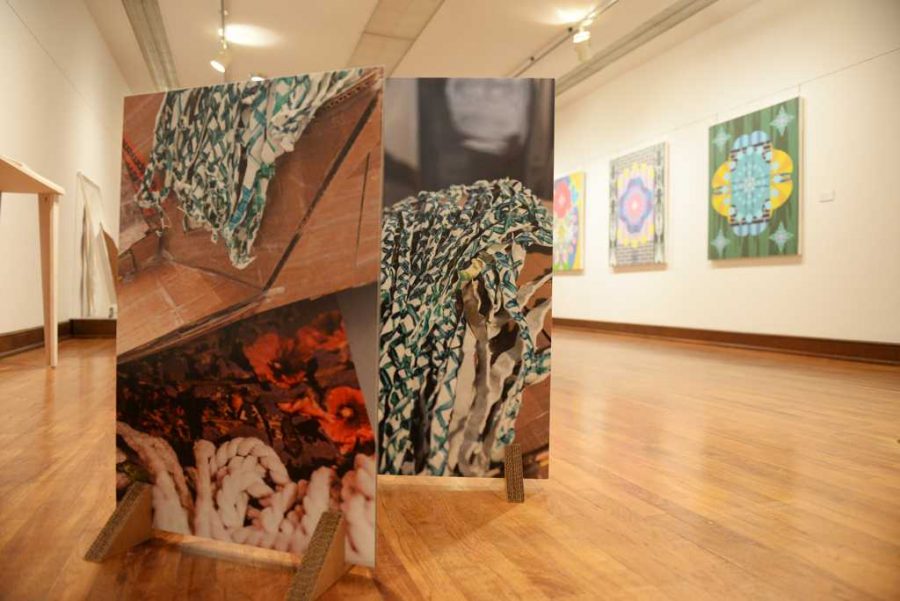The pieces in this fall’s Studio Arts faculty exhibit “Reverberations” do not have a connecting motive or medium but work together to represent the similarities between artists and teachers.
Vicky Clark, a Pittsburgh based independent curator responsible for organizing the Studio Arts faculty art exhibition in the Frick Fine Arts Building, named the exhibit “Reverberations” after she struggled to find a theme for the work that is only united by the artists’ connection to the University.
“Reverberations,” which features 14 members of Pitt’s Department of Studio Arts, opened last Thursday, Sept. 10, in the University Arts Gallery at the Frick Fine Arts Building. The exhibition is open 10 a.m. to 4 p.m., Monday through Friday, until Oct. 23.
“There’s no real visual or conceptual basis for this show, so what I get to do — and it’s wonderful — is find connections between the works that weren’t actually planned,” Clark said. “By working together, seeing and talking about each other’s work, conscious and subconscious connections emerge.”
Delanie Jenkins, associate professor and chair of the Studio Arts Department, said the Studio Arts faculty usually holds a collective exhibition every two or three years, but they delayed this show by a year to coincide with Pittsburgh’s hosting of the Southeastern College Art Conference’s annual meeting.
SECAC, a coalition of college visual art departments of which Pitt is a member, will hold its meeting from Oct. 21 to 24 at the Wyndham Grand Hotel downtown.
Clark is the first faculty exhibit curator to have no University affiliation.
“We’re a pretty collegial bunch,” Jenkins said. “This year we decided to try something a little different.”
As curator, Clark wrote the exhibition’s 84-page official catalog and discussed with the artists which of their pieces would go in the gallery.
Some artists repurposed older pieces for the exhibit. Jenkins originally designed the mirrored sculpture, Snow Fence, to reflect the dramatic sunsets and wide-open spaces of Wyoming, where she first displayed it.
“Interacting with the glass of the cloister gives it a sense of play, and this is one of the only places we could put it where it would reflect the Cathedral of Learning,” Jenkins said.
The centerpiece of the exhibition is “Portal,” a mixed-media installation crafted specifically for the Frick gallery by three collaborators: studio arts members Michael L. Morrill and Aaron Henderson as well as Mathew Rosenblum, director of graduate studies in the Music Department. “Portal” features four abstract paintings by Morrill, a series of spotlights set up by Henderson and an ambient musical score by Rosenblum.
Located in the gallery’s high-ceilinged rotunda, “Portal” uses Henderson’s spotlight array to mimic the way sunlight naturally illuminates the room through its many high, circular windows.
“Morrill’s four abstract paintings, based on annual solstices and equinoxes, anchor the space and provide sites for the reflection of the paths of light … That slow, rhythmic movement is enhanced with Rosenblum’s score, a sound piece that seems to emanate from the celestial spheres,” Clark wrote in the exhibition’s catalog.
Creating “Portal” required attention to every minute detail of the piece’s environment. According to Jenkins, the trio spent two years creating the installation, and Henderson said he started installing the lights back in June. To accurately determine where the sunlight falls in the rotunda on each day of the year, Henderson created a miniature 3-D model of the rotunda, which used to be a music room, and wrote his own custom software to power the lights.
“They’ve used a very awkward space in a very wonderful way. It echoes what the room was meant to be,” Clark said of the “Portal” team.
Henderson said he’s glad he sweated over the details.
“It’s one of those things where you feel a little bit of pride whenever you think of it,” Henderson said.
Clark said the gallery represents the passion the artists put into their work as creators and teachers.
“As a teacher, you put something out in the world and don’t always know what will come back, and the same is true for artists,” Clark said.


